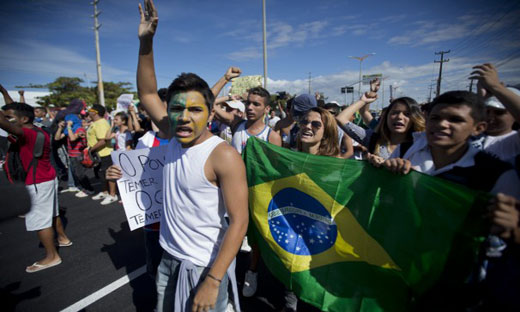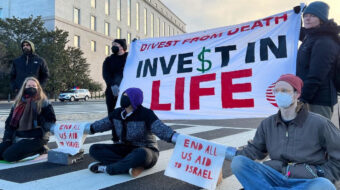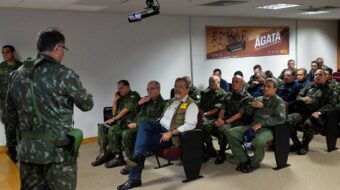
All last week, major Brazilian cities were the sites of massive youth protests. Although President Dilma Rousseff expressed sympathy with some of the grievances, promised wide ranging reforms, and reaffirmed the right of the Brazilian people to protest, there were also indications of efforts of right-wing activists as well as criminal elements trying to use the protests as cover for their agendas.
The demonstrations started on June 11 in São Paulo, as protests against an increase in bus and train fares. There was a heavy handed police response. Protests quickly spread to Rio de Janeiro and many other cities. Protesters began to raise many other issues, including the large amount of money that is being spent on preparations for the FIFA soccer World Cup, which will be hosted by Brazil next year, corruption, and dissatisfaction with the functioning of many institutions of Brazilian society, including schools and health care.
Although the initial crowds of protesters were mostly middle income and white, and thus not very representative of her own working class and multi-racial political base, President Rousseff of the left wing Workers’ Party (Partido dos Trabalhadores) expressed sympathy with the demonstrators, saying that such demonstrations show a healthy level of concern and a desire of ordinary Brazilian citizens to be included in political and societal decisions at all levels. The Brazilian left, including the two communist parties (the Communist Party of Brazil or PC do B, and the Brazilian Communist Party or PCB, both announced support for the movement.
On Friday June 21, there was a meeting in São Paulo of 76 important left wing and labor groupings, including the two communist parties, Rousseff’s own Workers’ Party, the Central Union of Workers (CUT) which is Brazil’s main trade union federation, the National Union of Students, the Brazilian Socialist Party and others. The purpose of the meeting was to come to an agreement on a broad agenda for change to be included in the demands of the demonstrations. The head of the Communist Party of Brazil in São Paulo State, Orlando Silva, said that the left should raise issues of housing, agrarian reform, and call for 10 percent of the GDP of the country to go for improving education.
Rousseff herself is a figure of the left, who spent time in prison and was tortured during the 1970s for participating in a guerilla movement to oust the military dictatorship that had overthrown the leftist president, João Goulart, in 1964. She was elected in 2010, succeeding Luiz Inaciio Lula da Silva, a former union activist from the Workers’ Party. Rousseff’s major focus has been on reducing extreme poverty in Brazil, through various programs such as the Bolsa Familiar (Family Purse), which makes direct cash transfers to poor families in exchange for their cooperation in keeping their children in school and up to date on immunizations. Under Lula and Rousseff, this program has pulled more than 36 million of Brazil’s 200 million people out of extreme poverty, and the president announced an expansion of the program in February of this year. Rousseff has been expected to be easily reelected in 2014.
But there have been difficulties. Growth of the Brazilian economy has been slow for the last two years. President Lula da Silva’s Workers’ Party had, by itself or in combination with other left parties, no majority in the 513 seat Chamber of Deputies or the 81 seat Senate, and so had to govern through coalition arrangements with shaky partners who did not share the ideology of the president. With Rousseff’s election came an expansion of the parliamentary left, but not enough for the president to get progressive legislation passed easily.
The Workers’ Party is also a very heterogeneous social-democratic formation, which has had its share of corruption scandals and political splits. Finally, the federal structure of the Brazilian government has meant that many of the state institutions and policies about which the protesters are complaining are not controlled by the federal government but by local politicians from parties not in Rousseff’s coalition. An example is Rio de Janeiro, whose mayor is not in sympathy with the president’s program.
As the demonstrations continued, with the participation of at least a million people nationwide, some right wing and even fascist tendencies began to show their faces.
Members of left groups who tried to display their banners and placards were attacked in some places. Criminal elements also had infiltrated the crowds and some violence and looting began to occur, notably an attempt to break into the Foreign Ministry building in the capital, Brasilia.
The fare increases in São Paulo and Rio de Janeiro were rescinded. President Rousseff spoke to the nation on Friday evening proposing three point program: The hiring of more doctors from overseas to improve the health care system, passage of a bill now in parliament which would dedicate all the state’s revenues from oil into the school system, and a general increase of federal government to problems of corruption and inefficiency in the country’s institutions. However, she defended the participation of Brazil in the World Cup, saying that the costs would be borne by private companies and that the Brazilian economy would benefit from the activities.
On Sunday, President Rousseff was set to meet with representatives of the “Free Pass” movement, which had initiated the demonstrations against the fare hikes.
Photo: Victor R. Caivano/AP












Comments